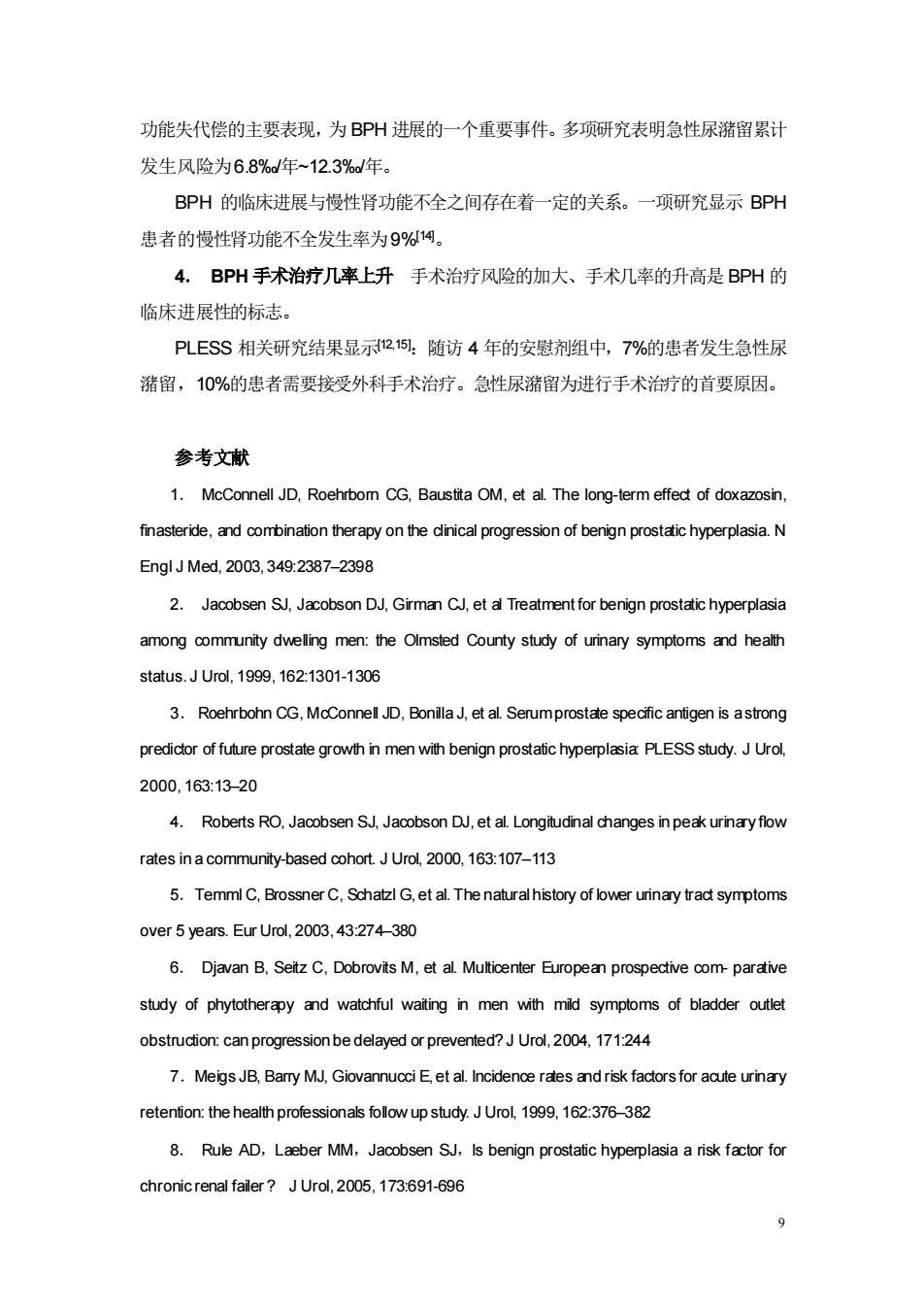正在加载图片...

功能失代偿的主要表现,为BPH进展的一个重要事件。多项研究表明急性尿猪留累计 发生风险为6.8%d年~12.3%d年。 BPH的临床进展与慢性肾功能不全之间存在者一定的关系。一项研究显示BPH 患者的慢性肾功能不全发生率为9%4。 4.BPH手术治疗几率上升手术治疗风险的加大、手术几率的升高是BPH的 临床进展性的标志。 PLESS相关研究结果显示2间:随访4年的安慰剂组中,7%的患者发生急性尿 潴留,10%的患者需要接受外科手术治疗。急性尿潴留为进行手术治疗的首要原因。 参考文献 1.McConnell JD.Roehrbom CG.Baustita OM.et al The long-term effect of doxazosin. finasteride.and comnaion therapyon the dinical progression of benign prostaichyperplasia.N Engl J Med,2003,349:2387-2398 2.Jacobsen SJ.Jacobson DJ,Girman CJ,et a Treatment for benign prostatic hyperplasia among community dweling men:the Olmsted County study of urinary symptoms and heath status.J Urol,1999,162:1301-1306 3.Roehrbohn CG.McConnell JD.Bonilla J.et al Serumprostate specific antigen is astrong predicor of future prostate growth men witn benign PLESS study.JUro 2000.163:13-20 4.Roberts RO,Jacobsen SJ.Jacobson DJ,et al.Longitudinal changes in peak urinary flow rates ina community-based cohort.JUrol,2000.163:107-113 5.TemmlC.BrossnerC.Schatzl G.et a The naturalhistory of lower urinay trad symptoms over 5 years.Eur Urol,2003,43:274-380 6.Djavan B.Seitz C,Dobrovits M,et al.Multicenter European prospective com-parative study of phytotherapy and watchful wating in men with mid symptoms of bladder outle obstrudion:can progression be delayed or prevented?J Urol,2004,171:244 7.Meigs JB.Bary MJ,GiovannucciE,et al.Incidence rates and risk factors for acute urinary retention:the health professionals followup study.JUrol,999,162:376-382 8.Rule AD,Laeber MM,Jacobsen SJ,Is benign prostaic hyperplasia a risk factor for chronicrenal failer?J Urol,2005,173:691-696 9 9 功能失代偿的主要表现,为 BPH 进展的一个重要事件。多项研究表明急性尿潴留累计 发生风险为6.8‰/年~12.3‰/年。 BPH 的临床进展与慢性肾功能不全之间存在着一定的关系。一项研究显示 BPH 患者的慢性肾功能不全发生率为9%[14]。 4. BPH 手术治疗几率上升 手术治疗风险的加大、手术几率的升高是 BPH 的 临床进展性的标志。 PLESS 相关研究结果显示[12,15]:随访 4 年的安慰剂组中,7%的患者发生急性尿 潴留,10%的患者需要接受外科手术治疗。急性尿潴留为进行手术治疗的首要原因。 参考文献 1. McConnell JD, Roehrborn CG, Baustita OM, et al. The long-term effect of doxazosin, finasteride, and combination therapy on the clinical progression of benign prostatic hyperplasia. N Engl J Med, 2003, 349:2387–2398 2. Jacobsen SJ, Jacobson DJ, Girman CJ, et al Treatment for benign prostatic hyperplasia among community dwelling men: the Olmsted County study of urinary symptoms and health status. J Urol, 1999, 162:1301-1306 3.Roehrbohn CG, McConnell JD, Bonilla J, et al. Serum prostate specific antigen is a strong predictor of future prostate growth in men with benign prostatic hyperplasia: PLESS study. J Urol, 2000, 163:13–20 4. Roberts RO, Jacobsen SJ, Jacobson DJ, et al. Longitudinal changes in peak urinary flow rates in a community-based cohort. J Urol, 2000, 163:107–113 5.Temml C, Brossner C, Schatzl G, et al. The natural history of lower urinary tract symptoms over 5 years. Eur Urol, 2003, 43:274–380 6. Djavan B, Seitz C, Dobrovits M, et al. Multicenter European prospective com- parative study of phytotherapy and watchful waiting in men with mild symptoms of bladder outlet obstruction: can progression be delayed or prevented? J Urol, 2004, 171:244 7.Meigs JB, Barry MJ, Giovannucci E, et al. Incidence rates and risk factors for acute urinary retention: the health professionals follow up study. J Urol, 1999, 162:376–382 8. Rule AD,Laeber MM,Jacobsen SJ,Is benign prostatic hyperplasia a risk factor for chronic renal failer ? J Urol, 2005, 173:691-696